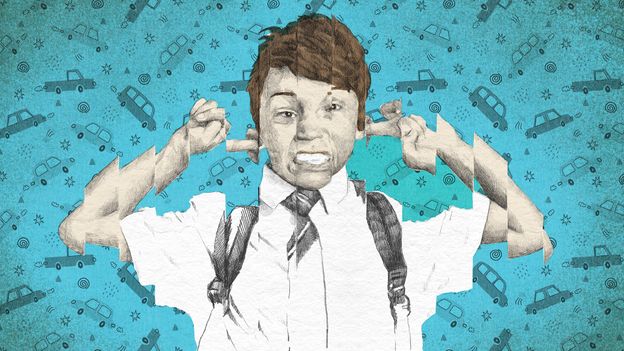- cross-posted to:
- [email protected]
- [email protected]
- cross-posted to:
- [email protected]
- [email protected]
That’s one of my first reasons for realizing that cars are a blight upon the land.
Ahhh man, you guys are going to make me take a few hours to shred this article. Alrighty. cracks knuckles
This article uses 3 definitions of noise:
- Noise: general background sound measured in db. not necessarily bad.
- Noise pollution: Defined as unwanted (in this case all background noise) or disturbing sounds
- Noise fluctuations: Sudden sounds tied to distracted behavior. This is the big important one and least talked about.
[formatting bug fix]
First of all, the link to “hurt children’s brains” as mentioned in the title is hyperbole; they are talking about distraction in the majority of the article. Yes, noise distracting. How much noise?
The World Health Organization recommends noise levels do not exceed 35 decibels in classrooms.
record scratch
35db?

Yeah, so basically everything. A distinguished fart for example.
Noise-induced hearing loss occurs after prolonged exposure to high levels of noise, exceeding 85 decibels.
The exposure time for hearing loss at 85db is 8 hours. That is a lot of continuous noise. I don’t record 85db INSIDE my old rickety car, let alone a classroom in residential zone 200’ away.
I think there is a dangerous disconnect between what this article calls cognitive harm and distraction. They are not interchangeable. It would make sense distracted children score lower on tests than non-distracted peers, but I wouldn’t call that harm. As someone with ADD, I take great offense in likening the two. In fact, if this article were rewritten as “traffic noise distraction for students” it would be MUCH more believable.
children between 5-11 years of age are especially vulnerable to noise if they have lower selective attention – meaning, the ability to maintain focus and block out unwanted distraction.
I was diagnosed when I kept looking at a air vent every time the building’s heater fan kicked in. Traffic was never a problem. Why? Because traffic sound becomes white noise. White noise actually helped me and many in my position focus. What did stand out were what the article calls “sudden fluctuations”
The researchers found that sudden fluctuations of noise […] were more likely to distract children, and cause them to miss important information, even at a lower than average noise level.
Congrats! You discovered ADD!
This article is filled with so many qualifiers “may”, “could”, “suggests”, “potentially” to vaguely link real science to assumptions. They want a connection that doesn’t exist; these words obfuscate libel. Ignore anything with any of these for it’s junk.
the Transit Authority installed rubber pads on the tracks to reduce noise, and the Board of Education equipped classrooms with sound-absorbing materials to create a better learning environment.
Sounds like these worked. The sound absorbing is probably a great way to go. Double pane windows help a ton too. Try noise canceling headphones as well!
noise exposure has also been associated with a greater diabetes risk
I actually found this sort of interesting and would like to know more about it, particularly a % increase, but it was paywalled. It could be minuscule for all I know.
The creation of the San Antoni superblock has lowered average daytime noise levels by 3.5 decibels
See decibel graphic above. Commence slow clap and thumbs up on their cough significance.
these things like “may” and “could”, etc. Are difficult to measure. But let’s make up an example.
1 in 10 students gets distracted from an annoying loud sound outside the classroom every once in a while. And for about half of them it results in them not being able to follow math class properly.
That results in about 5% of students (half of 1 in 10) to get lower grades. Unfortunate, and unnecessary.
Some things are hard to measure down to the tiny detail and with 100% accuracy. That’s why we compare scores from classrooms with different noise levels over the year and use claims like “a% to b% of students”.
While not super precise, it still shows accurate results
Sound like you may have grown up somewhere loud. Out here, 35db and below is normal. It’s that quiet outside at night, in most houses, in classrooms etc.
Obviously the occasional fart and talking student isn’t part of external noise pollution
Swing and a miss. No biggie.
Grew up off the beaten path with redwoods and a creek in the backyard.
You never went to school or grocery shopping? I mean more than just the house you lived in
Preschool was on a hill next to a cemetery. (Really creepy now that I think about it) Elementary was next to orchards, middle school by a post office and community center, high school had more traffic nearby but still never a distraction.
I don’t live there anymore, more big city vibes, but it’s all background sound.
Of sounds that stand out right now, we have airplanes and sirens as the distractions. Car noise is insignificant.
oh that’s really nice
3 dB is a doubling/having of sound pressure, so 3.5 is not nothing
As a seasoned sound engineer, yes.
But the scale is logarithmic so take “half of Barcelona’s population is exposed to noise levels of 65db”, subtract 3.5 from the chart above, and you get…
A conversation.
I did take precautions when I worked with a rock band monitoring the house. 25k watts can make a lot of sound pressure and 3db, along with exposure limits, were very important to keep an eye on.
Very informative, thanks !




